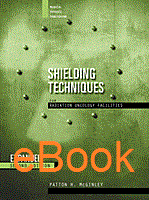
Shielding Techniques for Radiation Oncology Facilities, Second Edition
Author: Patton H. McGinleyISBN: 9781930524675
Published: 2002 | 184 pp | eBook
OUT OF PRINT
SCOPE (Review of the First Edition) | March 1999
Review of the First Edition:
"This book is intended as a practical guide to shielding methods for radiotherapy treatment rooms in light of new types of radiotherapy equipment and materials available over the last 20 years. Major NCRP references predate these, and this update is meant to aid in filling in the gaps. It is based on a course on shielding concerned with practical application and physical understanding, and contains a large number of worked examples and problems. It is not a formal mathematical development of radiation shielding theory. Aimed at senior/graduate level medical physics/health physics courses, or as a reference, the reader identified should have a radiation physics background. "The 9 chapters include: 1: The History of radiation shielding; 2 and 3: Conventional shield design and conventional maze design (both Megavoltage installations); 4, 5, and 6: Photoneutron production at energies higher than 10 MV and associated problems of shielding and maze design; 7: Other linac shielding topics: skyshine for x-rays and neutrons, ducting problems, air activation, ozone production, atriums and use of alternate shielding materials; 8: Simulators, HDR machines and brachytherapy sources and 9: Report writing and surveys. "The book is written for an American audience and sets out its radiation protection aims from the outset. Two areas are defined: a controlled area containing occupationally exposed personnel working to an ALARA level of <6mSv/annum, and an uncontrolled area where dose is limited to <1mSv/annum. In the chapters on linac room design, the examples are reasoned, and most necessary data is reproduced although the reader is referred to original NCRP publications on a couple of occasions. Equations and rules of thumb are stated without derivation. An appendix with derivations would have been useful, as would measurements verifying (or not) the quoted rules of thumb. Although protection levels are different to the IRR85 (and revised Draft) the examples are useful and present a workable approach to problems in this area. The text is written in metres and cm, however the regular appearance of 0.305 m safety margins around diverging beam projections hints at its imperial origins. "The book is particularly helpful for high megavoltage installations and problems associated with neutron production, covering an area in which the author has a lot of experience as can be seen from the references. "Chapter 8 on non-linac shielding is disappointing and shows its age in the use of units such as the Roentgen, and the lack of up to date references. There is a lack of consistency in the examples with two differing definitions of gamma factors for brachtherapy sources. There is also a lack of consistency in dose rate calculation points outside rooms, being 0.305 m outside linacs, but at the external wall of brachytherapy rooms. An interesting unit that appears here is the ''mcGy'. (Is this a translations of the mrem?) "The final chapter on report writing gives a useful summary on what should be contained in a report, however the suggestion of a scale 1/4" to 1 foot, is probably not recommended in Europe. "Overall I found the book useful for those designing high megavoltage rooms. It has a logical consequential approach--perhaps due to one main author--unlike IPEM Report 75: The Design of Radiotherapy Treatment Room Facilities and its index--also missing in IPEM 75--enables quick reference to relevant pages." Anielka Rembowska

